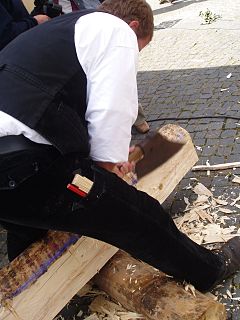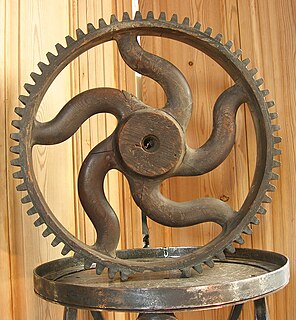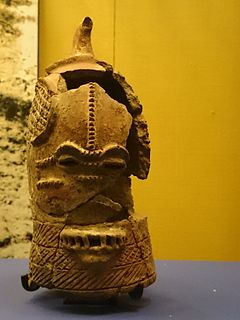
In the history of cryptography, Typex machines were British cipher machines used from 1937. It was an adaptation of the commercial German Enigma with a number of enhancements that greatly increased its security. The cipher machine was used until the mid-1950s when other more modern military encryption systems came into use.

In woodworking, hewing is the process of converting a log from its rounded natural form into lumber (timber) with more or less flat surfaces using primarily an axe. It is an ancient method, and before the advent of the industrial-era type of sawmills, it was a standard way of squaring up wooden beams for timber framing. Today it is still used occasionally for that purpose by anyone who has logs, needs beams, and cannot or would prefer not to pay for finished lumber. Thus homesteaders on frugal budgets, for example, may hew their own lumber rather than buy it.

Security printing is the field of the printing industry that deals with the printing of items such as banknotes, cheques, passports, tamper-evident labels, security tapes, product authentication, stock certificates, postage stamps and identity cards. The main goal of security printing is to prevent forgery, tampering, or counterfeiting. More recently many of the techniques used to protect these high-value documents have become more available to commercial printers, whether they are using the more traditional offset and flexographic presses or the newer digital platforms. Businesses are protecting their lesser-value documents such as transcripts, coupons and prescription pads by incorporating some of the features listed below to ensure that they cannot be forged or that alteration of the data cannot occur undetected.

The standard 52-card deck of French-suited playing cards is the most common pack of playing cards used today. In English-speaking countries it is the only traditional pack used for playing cards; in many countries of the world, however, it is used alongside other traditional, often older, standard packs with different suit symbols and pack sizes. The most common pattern worldwide and the only pattern commonly available in Britain and America is the English pattern pack. The second most common is the Belgian-Genoese pattern, designed in France, but whose use spread to Spain, Italy, the Ottoman Empire, the Balkans and much of North Africa and the Middle East. In addition to those, there are other major international and regional patterns.
Etruscan numerals could mean the words and phrases for numbers of the Etruscan language, or the symbolic notation used by the Etruscans to write them.

In sewing and fashion design, a pattern is the template from which the parts of a garment are traced onto fabric before being cut out and assembled. Patterns are usually made of paper, and are sometimes made of sturdier materials like paperboard or cardboard if they need to be more robust to withstand repeated use. The process of making or cutting patterns is sometimes condensed to the one-word Patternmaking, but it can also be written pattern(-)making or pattern cutting.

A tracing wheel, also known as a pattern wheel, pounce wheel, and dart wheel, is an instrument with multiple teeth on a wheel attached to a handle. The teeth can be either serrated or smooth. It is used to transfer markings from sewing patterns onto fabric with or without the use of tracing paper, and can be used to make slotted perforations. Such markings might include pleats, darts, buttonholes, notches or placement lines for appliques or pockets.

In sewing, to tack or baste is to make quick, temporary stitching intended to be removed. Tacking is used in a variety of ways:

Seam allowance is the area between the fabric edge and the stitching line on two pieces of material being sewn together. Seam allowances can range from 1⁄4 inch (6.4 mm) wide to as much as several inches. Commercial patterns for home sewers have seam allowances ranging from 1⁄4 to 5⁄8 inch.
The Joint Entrance Examination (JEE) is an engineering entrance assessment conducted for admission to various engineering colleges in India. It is constituted by two different examinations: the JEE Main and the JEE Advanced.

Markings on horses are usually distinctive white areas on an otherwise dark base coat color. Most horses have some markings, and they help to identify the horse as a unique individual. Markings are present at birth and do not change over the course of the horse's life. Most markings have pink skin underneath most of the white hairs, though a few faint markings may occasionally have white hair with no underlying pink skin. Markings may appear to change slightly when a horse grows or sheds its winter coat, however this difference is simply a factor of hair coat length; the underlying pattern does not change.

In casting, a pattern is a replica of the object to be cast, used to prepare the cavity into which molten material will be poured during the casting process.
The term patternmaking may refer to:
Paper data storage refers to the use of paper as a data storage device. This includes writing, illustrating, and the use of data that can be interpreted by a machine or is the result of the functioning of a machine. A defining feature of paper data storage is the ability of humans to produce it with only simple tools and interpret it visually.

The Maiden Stone, also known as the Drumdurno Stone after the nearby farm, is a Pictish standing stone near Inverurie in Aberdeenshire in Scotland, probably dating to the 9th century AD.

Darts are folds and sewn into fabric to take in ease and provide shape to a garment, especially for a woman's bust. They are used frequently in all sorts of clothing to tailor the garment to the wearer's shape, or to make an innovative shape in the garment. Fabric may be thought of as flat, and a dart has the effect of removing a wedge shaped piece and pulling the edges of that wedge together to create a shallow cone. This effect can be seen quite easily with a paper pattern by pulling together the edges of a dart intake as it would be sewn. Since fabric is generally more flexible than paper the fabric will shift around the apex of the cone and form a softer, but still curved, shape. In a garment a dart ends in a point at a full area of the body.
A patternmaker is a skilled worker who may produce patterns on paper or fabric for use in the clothing industry, or patterns (replicas) for use in the metalworking industry. A pattern maker makes clothes. One word.. patternmaker makes patterns for Foundries. In the 1930s to the '60s a patternmaker made more in wages than doctors and lawyers.

"Princess line" or "princess dress" describes a woman's fitted dress or other garment cut in long panels without a horizontal join or separation at the waist. Instead of relying on darts to shape the garment, the fit is achieved with long seams and shaped pattern pieces. A rarely used alternative name for the Princess line was French-dart-line dress.

The Lydenburg Heads refer to seven terracotta heads that were discovered in association with other pottery artefacts in Lydenburg, Mpumalanga, South Africa. They are among the oldest known African Iron Age artworks from South of the equator. Other artefacts found in association with these heads include ceramic vessels, iron and copper beads, and bone fragments. Charcoal associated with the heads was radiocarbon dated, and this relative dating technique places these artefacts and the site at around 1410 BP, which constitutes one of the earliest dates for an Iron Age settlement in South Africa. The heads are hollow with thin clay strips added to create facial details. The skill and thought that went into the designs suggest that they were valued products of a well organized and settled community.

The iPhone X is a smartphone designed, developed, and marketed by Apple Inc. The eleventh generation of the iPhone, it was available to pre-order on October 27, 2017 and was released on November 3, 2017.














